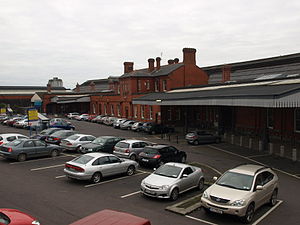- Cork Kent railway station
-
For other locations called Kent Station, see Kent Station (disambiguation).
Cork Kent 
Stáisiún Kent Cork Kent railway station Location Place Lower Glanmire Road, Cork Local authority Cork City Council Operations Station code 30 Platforms in use 5 History 1893 Station opened as Glanmire Road 1966 Renamed as Kent Station Iarnród Éireann - Ireland railway stations A B C D E F G H I J K L M N O P Q R S T U V W X Y Z Dublin to Cork Line Legend



Phoenix Park Tunnel (To Dublin Connolly) 



Luas Red Line (To Dublin Connolly) & (The Point) 

Dublin Heuston 




Luas Red Line (To Tallaght) 











Inchicore Works 







Park West & Cherry Orchard* 



Clondalkin/Fonthill* 



Kishoge 



Adamstown* 



Hazelhatch & Celbridge* 



Sallins & Naas* 



Newbridge* 



Kildare 



Dublin-Waterford Line 



Monasterevin* 



Portarlington 



Dublin-Westport/Galway 



Portlaoise 



Laoise Traincare Depot 



Limerick-Ballybrophy Line 



Ballybrophy 



Templemore* 



Thurles 







Limerick-Rosslare Line 



Limerick Junction 



Limerick-Ennis Line 



Limerick Colbert 



Charleville 



Mallow 



Mallow-Tralee line 



Cork Kent 



Cork-Cobh Line 



*Not served by through trains from Dublin to Cork Mallow to Youghal/Cóbh Legend


Dublin to Cork mainline 


Mallow-Waterford line 


Mallow 


Mallow-Tralee line 


Mourne Abbey 


Rathduff 


Blarney (Future) 


Monard (Future) 


Kilbarry (Future) 


Cork Kent 


Tivoli 


Dunkettle (Future) 


Little Island 


Glounthaune 



Carrigtwohill West (Future) 

Carrigtwohill 

Midleton 

Mogeely (closed) 

Killeagh (closed) 

Youghal (closed) 

Fota 

Carrigaloe 

Ballynoe (Future) 

Rushbrooke 

Cobh Kent Station (Irish: Stáisiún Kent) is an Iarnród Éireann train station in Cork, Ireland. Originally opened in 1893, the station operates as a hub for Intercity services to Dublin and Tralee and commuter services to Mallow, Cobh and Midleton.
Contents
Background
Name
The station was originally called Glanmire Road Station, but was renamed for Thomas Kent in 1966 on the 50th anniversary of the Easter Rising.
History
The station opened on 2 February 1893[1] and the current building was built in the same year. The station replaced two earlier stations that served as separate termini for the Great Southern and Western Railway (GS&WR) and Youghal Railway. The original GS&WR station for the Glanmire line was located directly in front of the portal of the tunnel through which the railway into Cork passed. And the original Cork & Youghal Railway terminus was above the tunnel portal.
The purpose of the new station was to allow through running of trains, following the 1865 takeover of the Cork and Youghal Railway by the Great Southern and Western Railway. The station is the only one of the 6 Cork railway stations that exists today.
The station served as a filming location for the 1979 movie The First Great Train Robbery starring Sean Connery, Donald Sutherland and Lesley-Anne Down.
Services
The station offers direct intercity rail services to Heuston Station and stations in Kerry. Cork Suburban Rail services follow the Cobh and Mallow lines. A new commuter line also operates to Midleton.[2]
The station has three terminating platforms 1-3 (in the Cobh direction) and two through platforms 4 and 5. Formerly there was an additional terminating platform adjacent to platform 3 numbered 4. Until the mid-1990s the through platforms were number 5 and 6. The former platform 4 was removed in 1984. Since December 2005's timetable change, the through platforms tend to get quite congested as commuter trains often come in together, clogging up limited space. Since the reopening of the Cork & Youghal Railway as far as Midleton increased use has been made of the terminating platforms 1 to 3.[citation needed] There is also a loop line behind platform 5, which used to be used to facilitate moving locomotives from the end of arriving trains to the other end in preparation for departure. This line used to be a double tracked freight avoiding line that enabled goods rans to bypass the passenger station. It is no longer necessary since all services to the station are operated either by railcars or by Mark 4 sets with a driving van trailer.[citation needed] The only platform not directly accessible from the station concourse, platform 5, is accessed through a subway, unlike most other Irish stations, which use footbridges.
The two station car parks are chronically undersized,[citation needed] and not restricted to rail travellers. Because they offer a flat rate of €7 per day, they are attractive to commuters and as a result it is very hard to secure a space after about 08:00.[citation needed]
Engine No. 36
An old locomotive is on permanent display in the concourse at Kent Station since 1950. "Engine No. 36" dates from 1847 and is displayed in the booking hall. Originally built by Bury, Curtis, and Kennedy of Liverpool at a cost of £1,955, the engine was obtained by the Great Southern and Western Railway to run services from Dublin to Cork. The engine remained in service until 1874.
She was displayed at the Cork exhibition in 1902, the Railway Centenary Exhibition in 1925 and the bi-centenary of the Royal Dublin Society at Ballsbridge in 1930. She was moved to a new position and restored by Iarnród Éireann in 2007.[3]
Gallery
References
- ^ "Kent station". Railscot - Irish Railways. http://www.railscot.co.uk/Ireland/Irish_railways.pdf. Retrieved 2007-08-31.
- ^ Irish Times - Cork-Midleton rail line to open - 30 July 2009
- ^ Display board at Cork Station
External links
Preceding station  Iarnród Éireann
Iarnród ÉireannFollowing station Terminus InterCity
Cork-TraleeMallow Mallow InterCity
Dublin-Cork Main LineTerminus Commuter
Cork-MallowTerminus Commuter
Cork-Cobh/MidletonLittle Island From 2012 Terminus Commuter
Cork-Cobh/MidletonDunkettle Kilbarry Commuter
Cork-MallowTerminus Listen to this article (info/dl)
This audio file was created from a revision of Cork Kent railway station dated 2006-06-20, and does not reflect subsequent edits to the article. (Audio help)More spoken articlesTransport in Cork Air Rail Road Water Port of CorkAgencies Coordinates: 51°54′06″N 8°27′32″W / 51.901786°N 8.458829°W
Categories:- Iarnród Éireann stations in County Cork
- Railway stations in County Cork
- Railway stations opened in 1893
Wikimedia Foundation. 2010.





